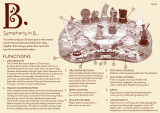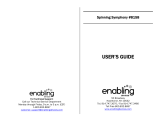
20 PSR-E213/YPT-210 Owner’s Manual
● Song List
• Some of the classic and/or traditional songs have been edited for length or for ease in learning, and may not be exactly the same as the original.
•A Song Book is available that includes scores for all internal songs (excepting Songs 1–3). To obtain the Song Book, complete the user registration at
the following website.
http://music.yamaha.com/registration/
● Other Operations
[REW] button ........... Fast-reverses the Song if pressed during playback (no sound is heard
during fast reverse). Decreases the measure number if pressed while
playback is stopped.
[FF] button................ Fast-forwards the Song if pressed during playback. Increases the
measure number if pressed while playback is stopped.
[PAUSE] button ........ Temporarily stops playback. Press this button a second time to resume
playback from the point at which it was stopped.
● Using the [DEMO] button
Press the [DEMO] button to play Songs 001, 002, 003, 059, 072, 004, 024,
043 in sequence, and playback will continue repeatedly starting again from
the first Song 001.
You can stop playback at any time by pressing the [DEMO] button.
No. Song Name
TOP PICKS
001 Cruisin
002 Winter Serenade
003 Castaway
ORCHESTRA
004
Danse des Mirlitons from “The
Nutcracker” (P.I. Tchaikovsky)
005
“Orphée aux Enfers” Ouverture
(J. Offenbach)
006 Slavonic Dances No.10 (A. Dvorák)
007
La Primavera (from Le Quattro
Stagioni) (A. Vivaldi)
008 Méditation (Thaïs) (J. Massenet)
009 Guillaume Tell (G. Rossini)
010 Frühlingslied (F. Mendelssohn)
011 Ungarische Tänze Nr.5 (J. Brahms)
PIANIST
012
Dolly’s Dreaming and Awakening
(T. Oesten)
013 La Candeur (J.F. Burgmüller)
014 Arabesque (J.F. Burgmüller)
015 Pastorale (J.F. Burgmüller)
016 Petite Réunion (J.F. Burgmüller)
017 Innocence (J.F. Burgmüller)
018 Progrés (J.F. Burgmüller)
019 Tarentelle (J.F. Burgmüller)
020 La Chevaleresque (J.F. Burgmüller)
021
Etude op.10-3 “Chanson de l’adieu”
(F. Chopin)
022 Marcia alla Turca (L.v. Beethoven)
023 Turkish March (W.A. Mozart)
024
Valse op.64-1 “Petit Chien”
(F. Chopin)
025 Menuett (L. Boccherini)
026 Nocturne op.9-2 (F. Chopin)
027
Moments Musicaux op.94-3
(F. Schubert)
028 The Entertainer (S. Joplin)
029
Prelude (Wohltemperierte Klavier
1-1) (J.S. Bach)
030 La Viollette (Streabbog)
031 Für Elise (L.v. Beethoven)
PRACTICE
032 America the Beautiful (S.A. Ward)
033 Londonderry Air (Traditional)
ˆ
034 Ring de Banjo (S.C. Foster)
035
Wenn ich ein Vöglein Wär ?
(Traditional)
036 Die Lorelei (F. Silcher)
037 Funiculi Funicula (L. Denza)
038 Turkey in the Straw (Traditional)
039 Old Folks at Home (S.C. Foster)
040 Jingle Bells (J.S. Pierpont)
041 Muss i denn (F. Silcher)
042 Liebesträume Nr.3 (F. Liszt)
043
Jesu, Joy Of Man’s Desiring
(J.S. Bach)
044 Ode to Joy (L.v. Beethoven)
045 Song of the Pearl Fisher (G. Bizet)
046 Gavotte (F.J. Gossec)
047
String Quartet No.17 2nd mov.
“Serenade” (F.J. Haydn)
048 Menuett (J.S. Bach)
049 Canon (J. Pachelbel)
050
From “The Magic Flute”
(W.A Mozart)
051
Piano Sonate op.27-2 “Mondschein”
(L.v. Beethoven)
052
“The Surprise” Symphony
(F.J. Haydn)
053 To a Wild Rose (E.A. MacDowell)
054 Chanson du Toreador (G. Bizet)
055 O Mio Babbino Caro (G. Puccini)
DUET
056
Row Row Row Your Boat
(Traditional)
057 On Top of Old Smoky (Traditional)
058
We Wish You A Merry Christmas
(Traditional)
059 Scarborough Fair (Traditional)
060 Im Mai (Traditional)
061 O Christmas Tree (Traditional)
062 Mary Had a Little Lamb (Traditional)
063 Ten Little Indians (Septimus Winner)
064 Pop Goes The Weasel (Traditional)
065
Twinkle Twinkle Little Star
(Traditional)
066
Close Your Hands, Open Your Hands
(J.J. Rousseau)
067 The Cuckoo (Traditional)
No. Song Name
068 O du lieber Augustin (Traditional)
069 London Bridge (Traditional)
CHORD LESSON
070
Bill Bailey (Won’t You Please Come
Home) (H. Cannon)
071
When Irish Eyes Are Smiling
(E.R. Ball)
072 Down by the Riverside (Traditional)
073
When the Saints Go Marching In
(Traditional)
074 Frühlingsstimmen (J. Strauss II)
075 Camptown Races (S.C. Foster)
076 Little Brown Jug (Joseph Winner)
077 Loch Lomond (Traditional)
078 Oh! Susanna (S.C. Foster)
079 Greensleeves (Traditional)
080 Aura Lee (G. Poulton)
081 Silent Night (F. Gruber)
082 The Danube Waves (I. Ivanovici)
083
Twinkle Twinkle Little Star
(Traditional)
084
Close Your Hands, Open Your Hands
(J.J. Rousseau)
085 The Cuckoo (Traditional)
086 O du lieber Augustin (Traditional)
087 London Bridge (Traditional)
088 American Patrol (F.W. Meacham)
089 Beautiful Dreamer (S.C. Foster)
090
Battle Hymn of the Republic
(Traditional)
091 Home Sweet Home (H. Bishop)
092
Valse Des Fleurs (From “The
Nutcracker”) (P.I. Tchaikovsky)
093 Aloha Oe (Traditional)
094
I’ve Been Working On The Railroad
(Traditional)
095 My Darling Clementine (Traditional)
096 Auld Lang Syne (Traditional)
097 Grandfather’s Clock (H.C. Work)
098 Amazing Grace (Traditional)
099 My Bonnie (H.J. Fulmer)
100 Yankee Doodle (Traditional)
101 Joy to the World (G.F. Händel)
102 Ave Maria (F. Schubert)
No. Song Name






















